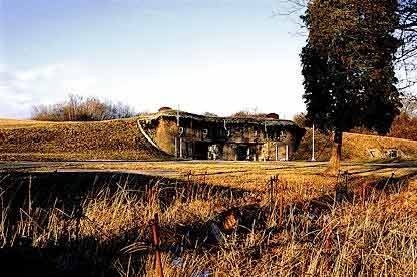The original Battle of the Bulge, 4 years before the Battle of the Bulge
The opening campaigns of World War II were some of the most brilliant military masterpieces ever seen. It became obvious in the spring of 1940 that war was inevitable. When Denmark and Norway fell, the Allies couldn’t believe the magnitude of what was happening. There were countless treaties and peace offerings made previous to the Polish and northern German advances. Now Poland, Denmark, and Norway had fallen. The British where thinking of blockades, RAF, and increasing their army. The French were extremely concerned especially about the German Luftwaffe.France was in the midst of political turmoil at home. Daladier resigned and was replaced by Paul Reynaud. Reynaud was thought to be more of an aggressor than Daladier. As history has shown, the French government wasn’t ready to undertake a war, shuffle of government or not.
The French Military was in a similar situation; they appointed General Alphonse Georges to be commander-in-chief of the northeast. This would have been a reasonable thing to do, except France already had a commander-in-chief of the army, General Maurice Gamelin. This command structure now created confusion within the French army. Messages between these two generals were lost and Gamelin consistently undermined Georges’ plans. The French didn’t heed the warning of Poland’s brutally quick fall. They attributed it to a negligent Polish military. Therefore the French didn’t, under Gamelin, setup in any significant way for a German onslaught. Their only increase came in their armored divisions, and that, at best, at a leisurely pace.
The Maginot Line

The French had entrenched along what was called the Maginot Line. Their experiences in World War I had taught them to be defensive and entrench. They where ill prepared for what was afoot. To the north of France are Belgium and Holland. Both Belgium and Holland had respectable armies with twenty-two divisions in the Belgian, and nine divisions in Holland. Between the two countries they had a few hundred aircraft. Both held neutrality closely, feeling they would be safe if they remained neutral. The Anglo-French alliance at this time had major difficulties cultivating any plans involving them.
The French based their plans on four assumptions. First, the Maginot line was impervious to attack. Second, that the Ardennes forest was impassable. Third, the Germans, they believed, had no choice but to repeat their World War I attack, the, Schlieffien plan. Finally, fourth was their belief that they could defeat the Schlieffien attack by sending units into Belgium and Holland.
The English and French assumed that once Germany attacked, the Belgians and Dutch would abandon their neutrality. It was planned that the French 7th Army (light armor) would be sent to aid them and create fortress Holland. The French would then reinforce with various infantry divisions. The big question of the day remained just how far should the Allies advance. They decided on the Dyle line "Antwerp to Namur".
The reason I have outlined all this information is because despite their misguided beliefs the Allies actually outnumbered the Germans.
| German | Allied | |
| Men | 2,000,000 | 4,000,000 |
| Divisions | 136 | 135 |
| Tanks | 2,439 | 2,689 |
| Aircraft | 3,200 | 2,400 |
Where was the mind set of Germany in all of this turmoil? What German Commander knowing these statistics would consider ordering the invasion of Western Europe? We all know the answer to that question. Hitler knowing these conditions ordered the planning of such an attack. Germany came up with Plan Yellow, a short-range version of the Schlieffien plan. The Germans struck on May 10th and the rest is history.
What isn’t widely know is that England and France could have won the war before any of this happened. When Germany was immersed in Poland, the German Western front had eight regular divisions in fair condition. The Allies had between seventy five to eighty divisions that were war ready and worthy. I am sure the Allies divisions were on alert due to the invasion in Poland that they saw lasting for weeks. Granted, the Polish defense had been smashed by day three of the German air/armored offensive, and this may have concerned the Allies, but a lot of Germany units had moved on to attack Denmark and Norway. While Britain declared war they continued to watch as Germany worked.
From September 1st 1939 to May 10th 1940 there was no action in Western Europe. Then Germany invaded Western Europe. More than half that time they were ill equipped to defend the Rhine land. The big question is then why didn’t France having the largest single army in Europe attack. Unfortunately, at the time, the general opinion was that the tactic of defense was best. Defensive postures had won the First World War. The big change that the Allies didn’t see quickly enough was that armor changed the face of land battle.. Armor gave the ability to move quickly - hence the Blitzkrieg.
These ideas are important as an example of failing to use the material that the Allies had in the beginning of the war. Many countries had already fallen to the Germans, both economically and militarily. The war had arrived and the Allies had done nothing in Western Europe to counter its arrival.
In our version of the game we reenact the Second Great War. The French ability to put the war down could be viewed as a wasted bid. Eighty divisions!! Imagine 80(uk)infantry in Western Europe, 8(Ger)infantry in Germany and 100(Ger)infantry in Eastern Europe.
What would you do, don’t waste your units, use them!
In Game terms I guess you could say it just wasn’t their turn. There was more there than meets the eye, more than a passing glance, but now its just history – or is it?
By
Solar
Back to TOP of page

